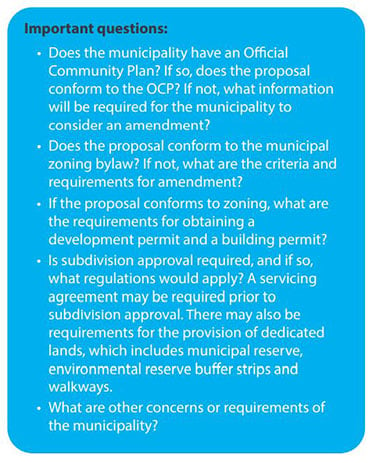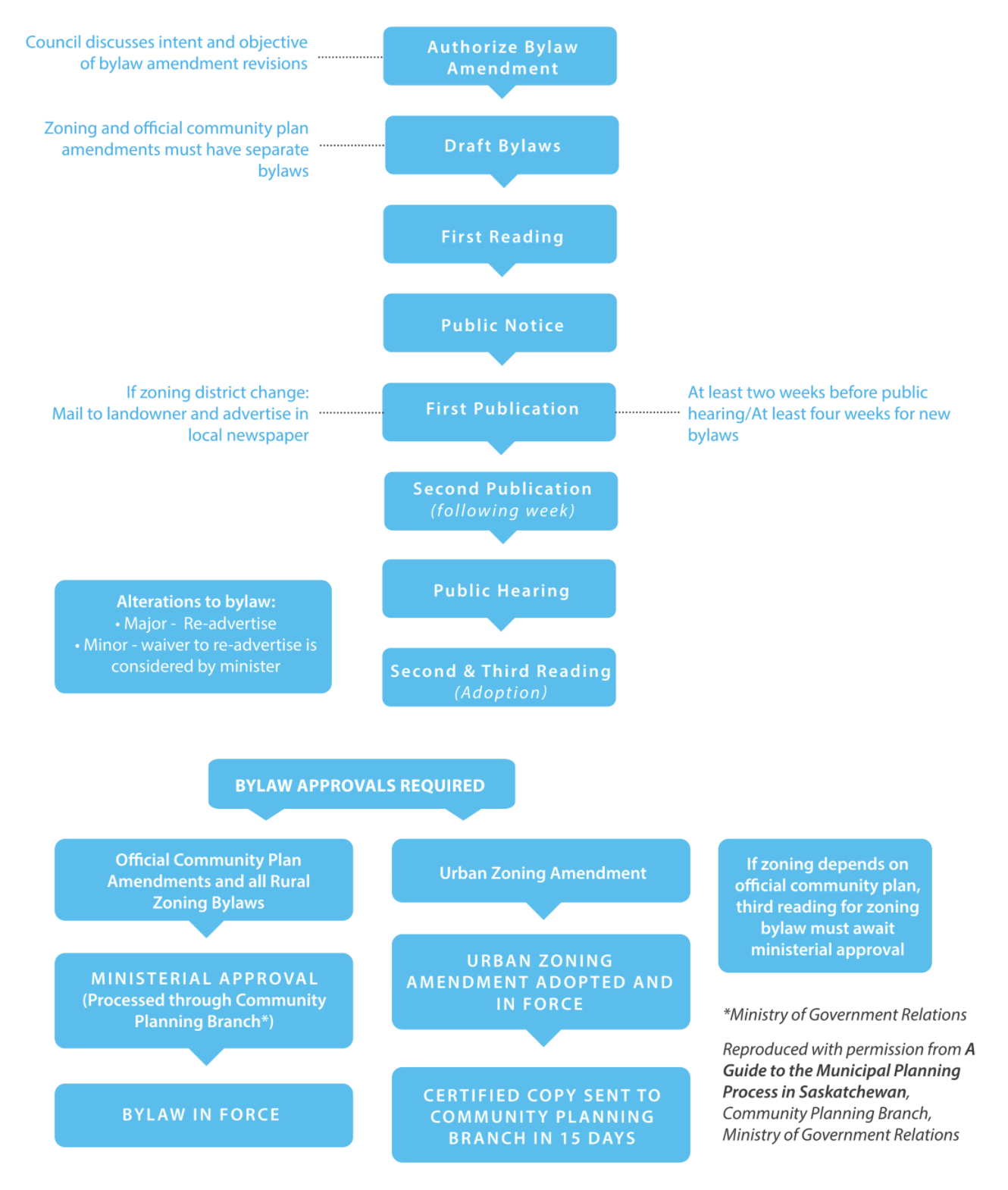This element of the development process is one of the most critical. Under The Planning and Development Act, 2007, municipalities have the authority to adopt an Official Community Plan (OCP). An essential component of a municipality’s planning process, the OCP is designed to guide future growth and development of the municipality. The parameters of an OCP extend beyond the physical development of a municipality, providing a policy framework to manage its environmental, economic, social and cultural development, as well.
An OCP is legally implemented by a zoning bylaw. Consequently, an early meeting with local municipal officials is essential. It will help determine the general municipal attitude toward the proposal and identify local requirements. Generally, the municipal administrator will advise on the procedures, timing and approvals of the municipal council. Contact with the community's economic development officer will also be useful.
All municipal development plans or basic planning statements established prior to May 21, 2007 (the day on which The Planning and Development Act, 2007 came into effect) are deemed to be an OCP pursuant to section 248 of the Act. These OCPs are continued in force as long as they are consistent with the Act, provincial land-use policies and statement of provincial interest.
 Municipal Statutory Plans
Municipal Statutory Plans
An increasing number of municipalities, both urban and rural, have adopted statutory plans containing broad policies or guidelines for the use of land. These are known as Official Community Plans (OCP).
The first step of the development process at the municipal level is to determine whether the municipality has an OCP in place and whether the proposed development is compatible with its policies and guidelines.
If the municipality has an OCP, the proposal must conform to its land-use policies. If this is the case, the next step is to check the proposal for conformity with current zoning regulations, as discussed in the upcoming section.
If the proposal does not fit the OCP, the next question is whether or not the municipality is prepared to make the necessary amendments. As the plans are based on considerable information and analysis by the municipality, the responsibility rests with the developer to provide information on the rationale, justification and benefits of the development.
At this point, a great deal of patience, diplomacy and willingness to address specific municipal concerns may be needed.
As suggested, it is advisable to prepare clear, written documentation of the physical, environmental, economic and financial implications of the proposal. The process of amending an OCP is summarized in the flow chart at the end of this chapter. This process, particularly the public meeting, is the point at which the proposal is most visible to public scrutiny. Thorough documentation of all issues and good public relations will facilitate the timely and successful completion of this phase of the development process.
Zoning Bylaws / Development and Building Permits
Zoning Bylaws are detailed municipal land-use controls that specify land-use zones or zoning districts, permitted and discretionary uses, regulations and development standards.
Development permits are issued by municipalities to signify conformity to the zoning bylaw before any construction proceeds. A building permit is usually required to signify conformity with the building code where a municipality has adopted a building bylaw pursuant to The Uniform Building and Accessibility Standards Act.
Development and building permits are required for virtually all types of tourism development. Often, they are issued at the same time, although procedures vary from municipality to municipality. Generally, this is a straightforward procedure involving submission of an application form, a site plan and building plans to the municipality. Approval is likely to be a matter of weeks rather than months.
If the proposal does not conform to the zoning bylaw, the municipality may be prepared to consider a zoning amendment. The process of amending a zoning bylaw is summarized in the flow chart. In general, the following apply:
- Process is similar to an OCP amendment
- Approximately two months minimum time required
- Advertising and public meeting required
- Developer usually pays advertising cost
- No formal appeal to council decision
- OCP / zoning bylaw amendment and/or subdivision review processes may be done jointly
Again, while municipalities usually support sound development proposals, the responsibility remains with the developer to demonstrate the social, environmental and economic benefits to the community.
To summarize, the significance of the municipality's role in the development process cannot be over-emphasized.
Municipal Planning Information:
- To access information on The Planning and Development Act, 2007, community planning process and zoning, consult the Community Planning, Land Use and Subdivision Branch of the Ministry of Government Relations.
Official Community Plan and / or Zoning Amendment Process





















